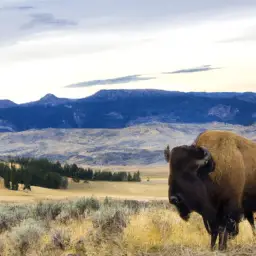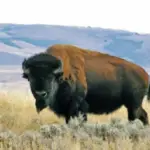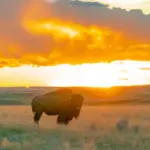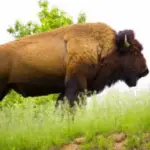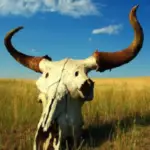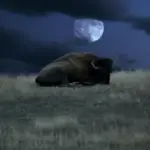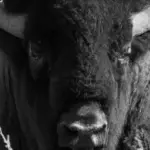Imagine you’re standing at the iconic Yellowstone National Park, marveling at its breathtaking landscapes and vibrant wildlife. Amidst the rugged beauty, you can’t help but wonder about the intricate details of this natural wonder. In particular, you find yourself pondering the intriguing question: How many bison call Yellowstone home? In this article, we will uncover the fascinating answer to this query and explore the significance of these majestic creatures in the park’s ecosystem.
Historical Population of Bison in Yellowstone
Pre-20th century bison numbers in Yellowstone
Before the arrival of European settlers, the Yellowstone region was home to a thriving bison population. Estimates suggest that there were once between 20,000 to 60,000 bison roaming the vast grasslands and prairies of Yellowstone. These magnificent animals were a cornerstone of the ecosystem and played a crucial role in the lives of indigenous tribes who depended on them for food, clothing, and spiritual sustenance.
Major decrease in bison population
Unfortunately, the once abundant bison population in Yellowstone faced a major decline in the late 19th century. Unregulated hunting, driven by the demand for bison hides and the desire to control Native American populations, led to an alarming decrease in bison numbers. By the late 1800s, fewer than 1,000 bison remained in Yellowstone, pushing them to the brink of extinction.
Repopulation efforts
In response to the alarming decline in bison populations, efforts were made to reintroduce bison to Yellowstone National Park. In the early 1900s, a small number of bison were brought back to the park, laying the foundations for their eventual recovery. Over the years, these repopulation efforts have proven to be successful, and the bison population in Yellowstone has rebounded significantly. Today, Yellowstone is home to one of the largest and most iconic bison herds in North America.
Current Bison Population in Yellowstone
Annual bison counts
To track the progress of the bison population in Yellowstone, annual counts are conducted. These counts provide valuable information on population size, distribution, and overall health of the herd. They play a critical role in assessing the success of conservation efforts and informing management strategies.
How the count is done
The bison population count in Yellowstone is carried out through a combination of ground-based surveys and aerial observations. Park rangers and scientists traverse designated areas, meticulously documenting the number of bison they encounter. In addition, aerial surveys are conducted to complement ground-based efforts, offering a comprehensive understanding of the bison population dynamics across the vast landscape of Yellowstone.
Challenges in counting the bison population
Counting the bison population in Yellowstone poses its own set of challenges. The sheer size and rugged terrain of the park make it difficult to accurately assess the entire herd. Additionally, bison are highly mobile animals, often moving long distances in search of food and water. This makes it necessary for researchers to employ various techniques and strategies to ensure an accurate count. Despite these challenges, Yellowstone’s diligent monitoring efforts provide valuable insights into the status and trends of the bison population.
Understanding Bison Behavior
Bison versus other animals in Yellowstone
Bison are one of the most conspicuous and charismatic species in Yellowstone. They share the landscape with a diverse array of animals, including elk, wolves, grizzly bears, and numerous avian species. Bison, with their imposing size and distinctive hump, are well adapted to survive in the harsh and ever-changing environment of the park. Their resourceful nature and ability to adapt to different foraging conditions make them a fascinating species to study.
Bison migratory patterns
Bison in Yellowstone exhibit unique migratory patterns, moving across vast distances within and beyond the park boundaries. They undertake long-distance migrations during the spring and fall, following age-old paths that lead them to lower elevations in search of nutritious forage. These migrations not only enable bison to access a diverse range of habitats but also play a crucial role in shaping the ecosystem dynamics of the region.
The role of bison in the ecosystem
Bison are often referred to as ecosystem engineers due to the profound influence they have on their surroundings. Their foraging habits and grazing behavior shape the vegetation composition, leading to changes in plant diversity and abundance. By exerting selective pressure on certain plant species, bison create a mosaic of habitats that support a wide range of other wildlife, including birds, insects, and small mammals. The ecological importance of bison cannot be overstated, as their presence and activities contribute to the overall health and vitality of the Yellowstone ecosystem.
Impact of Habitat on Bison
Role of Yellowstone’s environment in supporting bison
The unique environment of Yellowstone National Park provides an ideal habitat for bison. The park’s expansive grasslands, meandering rivers, and diverse topography offer abundant forage and water sources essential for the survival of these magnificent animals. The availability of suitable habitat allows the bison population to thrive, ensuring the continued existence of this iconic species in Yellowstone.
Effects of climate change on bison habitat
Climate change poses a significant threat to the bison habitat in Yellowstone. Rising temperatures, altered precipitation patterns, and the increased frequency of extreme weather events can disrupt the availability of food and water for bison. These changes may lead to the modification of vegetation communities and alter the migratory paths followed by bison. Adapting to these changing conditions will be essential for the long-term survival of bison in Yellowstone.
Human-induced changes in bison habitat
Human activities have also had a lasting impact on bison habitat in Yellowstone. The construction of roads, infrastructure development, and alteration of natural waterways can fragment the landscape, impeding the movement of bison and restricting access to vital resources. Furthermore, the encroachment of human settlements and land use changes can result in conflicts between bison and local communities, further influencing the availability and quality of habitat for these majestic creatures.
Bison Management in Yellowstone
Yellowstone’s bison management strategy
The National Park Service (NPS) has the responsibility of managing the bison population in Yellowstone. Their management strategy focuses on maintaining a healthy and genetically diverse herd while minimizing conflicts with human activities and conserving the integrity of the ecosystem. The NPS collaborates with other government agencies, Native American tribes, and stakeholders to develop comprehensive management plans that balance the needs of bison and the surrounding communities.
Role of the National Park Service
The National Park Service plays a critical role in the conservation and preservation of bison in Yellowstone. They conduct scientific research, monitor population dynamics, and implement management actions to protect and enhance the bison population and its habitat. This includes measures such as habitat restoration, herd health monitoring, and public education initiatives to foster a deeper understanding and appreciation for bison and their role in the Yellowstone ecosystem.
Controversies surrounding bison management
Bison management in Yellowstone has been a topic of controversy and debate. Issues such as brucellosis transmission, bison migrations outside the park boundaries, and conflicts with agriculture have sparked intense discussions and differing viewpoints. Balancing the interests of various stakeholders, including ranchers, wildlife advocates, and indigenous communities, poses significant challenges. The National Park Service strives to engage in dialogue and seek collaborative solutions to address these complex issues while ensuring the long-term sustainability of the bison population.
Bison and Human Interaction in Yellowstone
Frequency of human-bison encounters
Given the popularity of Yellowstone National Park, interactions between humans and bison are relatively common. Visitors are often treated to awe-inspiring sightings of these magnificent creatures from a safe distance. However, it is important to remember that bison are wild animals and should be observed with caution and respect for their space and boundaries.
Safety measures for interacting with bison
To ensure the safety of both visitors and bison, the National Park Service provides guidelines for interacting with these iconic animals. These guidelines include maintaining a safe distance, refraining from approaching or feeding bison, and being aware of signs of agitation or aggression displayed by the animals. By following these safety measures, visitors can enjoy the unparalleled experience of observing bison in their natural habitat while minimizing potential risks.
Cases of bison attacks on humans
While bison attacks on humans in Yellowstone are relatively rare, they can occur if individuals disregard safety precautions or venture too close to the animals. Bison are formidable and can become aggressive if they feel threatened or provoked. In such instances, it is crucial to remain calm, slowly back away, and seek immediate assistance from park rangers. Understanding and respecting the behavior and boundaries of bison are essential for ensuring the safety of both humans and these majestic creatures.
Roles of Bison in Yellowstone Ecosystem
Bison’s effect on plant diversity
The presence of bison has a profound impact on plant diversity within the Yellowstone ecosystem. Through their selective grazing, bison help control the dominance of certain plant species, allowing for a more diverse array of vegetation to flourish. This diversity, in turn, supports a wide range of other wildlife, including insects, birds, and small mammals, creating a rich and vibrant ecosystem.
Bison’s contribution to the nutrient cycle
Bison play a crucial role in nutrient cycling within the Yellowstone ecosystem. Through their grazing and movement patterns, bison redistribute nutrients across the landscape. Their waste acts as a source of organic matter, enriching the soil and facilitating the growth of plants. This nutrient cycling process ensures the continuity of ecosystem functions and contributes to the overall resilience and sustainability of Yellowstone’s ecological processes.
Interaction between bison and other species
The presence of bison in Yellowstone facilitates intricate ecological interactions with other species. For instance, bison create wallows, depressions in the ground formed through their rolling behavior. These wallows attract a variety of animals, such as songbirds, insects, and amphibians, who rely on the moist conditions and available resources. Additionally, bison carcasses provide sustenance for scavengers, contributing to the intricate web of life within the park.
Key Threats to Bison Population in Yellowstone
Diseases affecting bison
Bison in Yellowstone face several health challenges, including the risk of diseases such as brucellosis. Brucellosis is a bacterial infection that can cause reproductive issues in bison, leading to concerns about transmission to domestic livestock. Efforts to manage and reduce the prevalence of brucellosis in bison remain critical to ensure the long-term viability of the Yellowstone bison population.
Predators of bison
While Yellowstone is home to predators such as wolves and grizzly bears, adult bison are generally not targeted by these animals. Instead, predators tend to focus on vulnerable bison calves or individuals weakened by disease. The balance between predation and population dynamics of bison is delicate, and understanding these interactions is crucial for maintaining the ecological integrity of the park.
Impact of tourism
The increasing popularity of Yellowstone as a tourist destination brings its own set of challenges for the bison population. Large numbers of visitors can disrupt the natural behavior of bison and their habitat, leading to stress and altered patterns of movement. Park managers need to strike a delicate balance between offering visitors the opportunity to connect with wildlife and ensuring the well-being and conservation of the bison population.
Convalescence and Conservation Strategies
Current conservation efforts
Conservation efforts for bison in Yellowstone are ongoing and multifaceted. They include habitat restoration projects, public education initiatives, breeding programs, and collaborations with indigenous tribes and other stakeholders. These efforts aim to continue the recovery and long-term viability of the Yellowstone bison population while promoting sustainable coexistence between humans and these iconic animals.
Future plans for bison conservation
Looking ahead, future conservation plans for bison in Yellowstone will focus on addressing emerging challenges, such as climate change and disease management. Strategies may include adaptive management approaches, genetic monitoring, and landscape-scale conservation measures to ensure the preservation of bison and their habitat for future generations.
Role of research in conservation
Scientific research plays a crucial role in informing conservation efforts for bison in Yellowstone. Ongoing studies help deepen our understanding of their behavior, habitat requirements, and ecological interactions. They also provide valuable data for making informed management decisions and developing evidence-based strategies to protect the Yellowstone bison population and its ecosystem.
How Does the Bison Rut Impact the Bison Population in Yellowstone?
The bison rut schedule in Yellowstone plays a crucial role in the population dynamics of these iconic creatures. During the rut, male bison compete for mating rights, which can impact the genetic diversity of the herd. Understanding the bison rut schedule in Yellowstone helps in managing the population effectively.
Importance of Bison in Indigenous Cultures
Historical significance of bison
Bison have long held immense cultural and spiritual significance for indigenous tribes in the Yellowstone region. For many tribes, bison were not just a source of sustenance but a symbol of strength, resilience, and interconnectedness with nature. They formed the cornerstone of tribal economies, provided materials for shelter and clothing, and played a central role in sacred ceremonies and traditions.
Current cultural and spiritual ties with bison
The deep cultural and spiritual ties between indigenous tribes and bison continue to this day. Many tribes actively participate in bison conservation efforts, collaborating with park authorities and other stakeholders to ensure the preservation of bison populations in Yellowstone. These efforts are driven by a profound understanding of the intricate relationship between indigenous peoples and bison and a shared commitment to safeguarding this iconic species for future generations.
Role of indigenous tribes in bison conservation
Indigenous tribes in the Yellowstone region have emerged as crucial partners in bison conservation. Their traditional ecological knowledge and stewardship practices provide invaluable insights into the management and preservation of bison and their habitat. Moreover, by actively engaging in conservation initiatives, indigenous tribes are reclaiming their rightful roles as stewards of the land and reinforcing the importance of bison in maintaining cultural, spiritual, and ecological balance.
In conclusion, the historical population of bison in Yellowstone faced a dramatic decline in the past due to unregulated hunting and human encroachment, but remarkable repopulation efforts have led to the recovery of this iconic species. The current bison population in Yellowstone is carefully monitored through annual counts, which present their own challenges. Understanding bison behavior, the impact of habitat on their survival, and effective bison management strategies are of utmost importance. While human interactions with bison are frequent, safety measures and awareness campaigns mitigate potential risks. Bison play critical roles in the Yellowstone ecosystem, contributing to plant diversity, nutrient cycling, and intricate ecological interactions. However, the bison population still faces threats such as diseases, predation, and impacts from tourism. Ongoing conservation efforts, future plans, and the involvement of indigenous tribes are vital for the continued survival and cultural significance of bison in Yellowstone.

